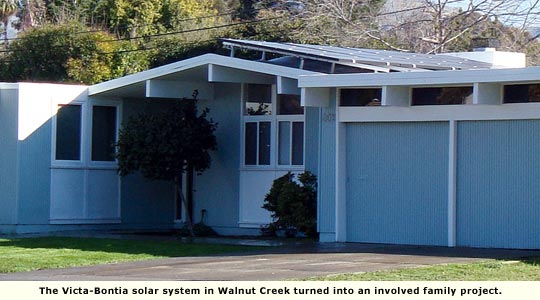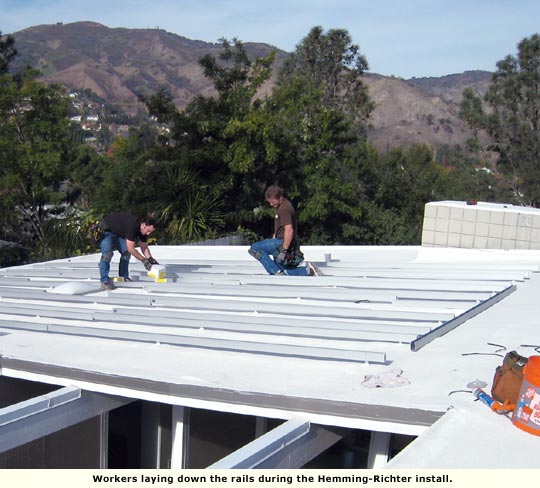Energy: Sun Power Rising - Page 3
Not every house can practically utilize solar. Even though a residential roof gets sun for most of the day, it may or may not be enough sun to make a solar electric installation cost-effective. A solar contractor should carefully evaluate each potential installation site. If there is not full access to the sun, year-round, it may take longer for the system to pay for itself, which in turn would increase the operation time needed for return on investment. Removing or trimming back trees on a property oftentimes can help improve access to the sun.
Michael Hemming and Susanne Richter, owners of an Eichler in Granada Hills, installed a PV system with the help of Kristina Hahn, a Los Angeles-based architect, and a handful of other key players. The couple installed their PV system on the northeast corner of the roof, which avoided shadows created by tall trees in the yard.
Architects Alexander Victa and Cristina Bontia, Eichler owners in the Rancho San Miguel development of Walnut Creek, decided to go solar in an effort to make their home, which they bought as a fixer-upper in 2006, more energy efficient and ecologically conscious.
"When we were looking to buy this house, it seemed to have the best orientation for solar panels on the roof," Bonita says. "It's on a corner lot without a lot of trees around it, and the angled part of the roof was oriented to the southwest."
The couple has Leadership in Energy and Environmental Design (LEED) accreditations, so energy efficiency was especially important to them. "We thought that experimenting on our own house would not only educate us on residential 'green' design, but also give us a first-hand experience of living in an eco-Eichler," Victa says.
For Victa and Bontia, installing PV panels proved to be the best way to offset the energy costs of a new high-velocity/low-profile HVAC system, and the challenge was to coordinate the solar installation with a new foam roof. They chose flat-pack solar panels for their easy shipping and low-profile appearance and had them installed on the pitched area of the center of the house instead of the flat areas of the roof. The panels had to be mounted on structural footings, as required by the city inspector, which rested on the main beams of the house.

Unfortunately, the couple's original solar contractor went out of business halfway through their project, so Victa, his father Arnaldo (an electrical engineer), and his uncle Danilo (a mechanical contractor) came together to complete the install.
With these setbacks, the entire projects took about six months to complete and, according to Alexander Victa, cost approximately $16,000. The lag time and final cost, he says, were well worth it, however. After one year of having the PV cells on their house, combined with improved insulation value of our walls, the couple's total heating bill for the year was reported at -$150. The utility company charged $9 per month for metering costs.
Kevin and Jennifer Gray, owners of an Eichler in Thousand Oaks, added 30 150-watt BP Solar modules to his roof (rated at 4.5 kilowatts of power) in 2004. The system provides a large surplus of power, and the Grays report that they have had no electric bills since installation.
"The thing I like about solar is that it completely isolates us from any rate increases, and we make so much more than we use," Kevin Gray says. "We are part of the solution instead of the problem. Our system is pumping power into the system during peak times, and we end up with a $200 to $300 [annual] credit."
The Grays' system is running with two metering plans in place: net metering, which tracks our basic yearly production and consumption; and TOU metering, which enables him to sell PV-produced power back to SCE for up to 50 cents per kilowatt hour during peak times during the day (depending on market conditions) and buy power back at a deeply discounted rate during the night. Overall, the system cost the Grays just over $28,000 and the couple anticipates it will be 20 years before they earn a complete return on their investment.
Kevin says he was particularly pleased with the way his system blended into the home's roofline. "I wanted to do as little violence as possible to the aesthetics of my home," he explains. "From most angles, the neighbors can't see the system, and people continue to ask us when we will be putting it in—so that makes it an aesthetic success."





